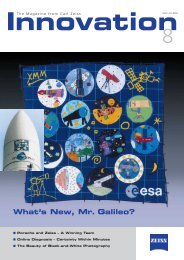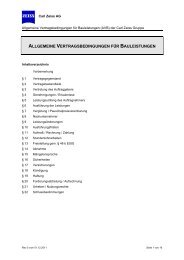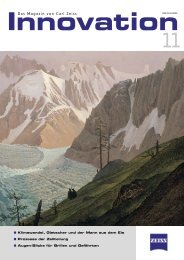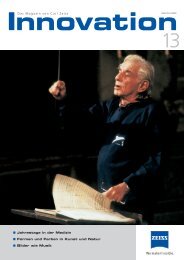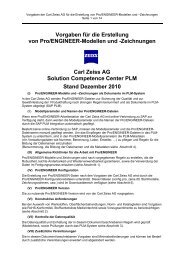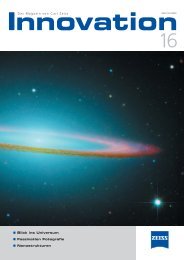Download PDF - Carl Zeiss
Download PDF - Carl Zeiss
Download PDF - Carl Zeiss
Create successful ePaper yourself
Turn your PDF publications into a flip-book with our unique Google optimized e-Paper software.
Felix Anton Dohrn<br />
Innovation 15, <strong>Carl</strong> <strong>Zeiss</strong> AG, 2005<br />
Anton Dohrn founded the zoological<br />
station in Naples in 1870.<br />
For decades it was the leading<br />
international center for marine<br />
research.<br />
Anton Dohrn was a zoologist and<br />
one of the first outstanding researchers<br />
of phylogeny. He came from a<br />
well-to-do family in the German city<br />
of Stettin. In his early childhood, he<br />
learned that art and science coexist<br />
and interact: his father <strong>Carl</strong> August<br />
(1806-1892) corresponded with artists,<br />
poets and scientists such as<br />
Alexander von Humboldt and Felix<br />
Mendelsohn. His children were required<br />
to “know their Goethe”, be<br />
knowledgeable about music and<br />
share his passion for science.<br />
Anton Dohrn, 1898,<br />
drawing by<br />
Johannes Martini.<br />
Dohrn studied in Königsberg, Bonn<br />
and Jena under Rudolf Virchow, Ernst<br />
Haeckel and <strong>Carl</strong> Gegenbaur. Following<br />
his studies in medicine and zoology,<br />
he became interested in the<br />
theories of Darwin. In 1870, he founded<br />
the zoological station for the<br />
research of marine fauna in Naples,<br />
Italy, one of the first marine research<br />
centers. He also studied the phylogeny<br />
of arthropods based on embryological<br />
and comparable anatomical data.<br />
Building on his insights, he was<br />
the first to suggest that vertebrates<br />
evolved from annelids. Furthermore,<br />
he described the “principle of the<br />
change of functions”.<br />
Dohrn earned his doctorate in<br />
1865 in Breslau. He qualified as a<br />
lecturer in 1868 in Jena and taught<br />
zoology until 1870. From 1874 until<br />
his death, he was director of the marine<br />
research station in Naples, Italy<br />
(Stazione Zoologica di Napoli). In<br />
1874 he married 16 year old Marie<br />
de Baranowska.<br />
Despite his nationality and cultural<br />
origins, Anton Dohrn received considerable<br />
support from the British<br />
natural science tradition during the<br />
realization of his dream of founding<br />
a marine biology laboratory. At the<br />
annual meeting of the British society<br />
in 1870 in Liverpool, a committee<br />
was founded with the intention of<br />
promoting the foundation of zoological<br />
stations in different regions of the<br />
world. In fact, it was this committee<br />
that increased the fame of Dohrn’s<br />
zoological station in Naples in the English-speaking<br />
world with regularly<br />
published reports and articles in Nature.<br />
Felix Anton Dohrn<br />
Born December 29, 1840,<br />
in Stettin,<br />
Died September 26, 1909,<br />
in Munich<br />
“…not only that Abbe provided<br />
new instruments at<br />
a very low price, or even<br />
donated them, he also received<br />
suggestions from there,<br />
the control of the practice,<br />
the critical thoughts of experience.<br />
The station was also<br />
a place where foreign researchers<br />
were introduced to<br />
and acquired <strong>Zeiss</strong> equipment,<br />
and then announced the<br />
splendor of superior German<br />
workmanship in their home<br />
countries. The station was<br />
almost a type of ideal export<br />
warehouse and Dohrn was<br />
delighted to write to Abbe<br />
that Balfour acquired this<br />
apparatus and he wants one<br />
for everyone…”<br />
Theodor Heuss was friends<br />
with Dohrn’s son Boguslav<br />
who, on the 100 th birthday of<br />
the great natural scientist in<br />
1940, requested that Heuss<br />
write a comprehensive<br />
summary of the life work<br />
of Anton Dohrn.<br />
From “Anton Dohrn: A Life for Science”<br />
by Theodor Heuss (1940)<br />
29




